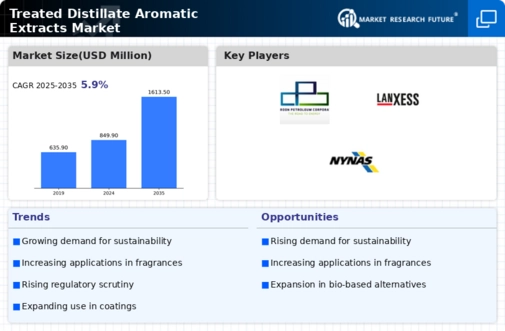Market Trends
Key Emerging Trends in the Treated Distillate Aromatic Extracts (TDAE) Market
The Treated Distillate Aromatic Extracts (TDAE) market is influenced by several key market trends that shape its dynamics and growth trajectory.
Shift Towards Environmentally Friendly Rubber Processing Oils: There is a growing trend towards environmentally friendly rubber processing oils, driven by increasing regulatory scrutiny and consumer demand for sustainable products. TDAE, being derived from low aromatic content base oils, is gaining popularity as a greener alternative to traditional aromatic extract oils. Manufacturers are focusing on developing TDAE formulations that offer high performance while meeting stringent environmental regulations, leading to increased adoption of TDAE in the rubber industry.
Rising Demand for Tire Manufacturing: The tire manufacturing industry represents a significant market for TDAE, as it is used as a processing aid and extender oil in tire compounding. With the growing automotive sector worldwide and increasing demand for tires, especially in emerging economies, the demand for TDAE in tire manufacturing is on the rise. TDAE offers advantages such as improved processability, reduced rolling resistance, and enhanced tire performance, driving its demand in the tire industry.
Focus on Enhanced Performance and Product Quality: Manufacturers of TDAE are increasingly focusing on enhancing product performance and quality to meet the evolving requirements of end-users in various industries. Advanced refining processes and formulation techniques are being employed to produce TDAE oils with superior properties such as low volatility, high viscosity index, and excellent compatibility with rubber compounds. The emphasis on product innovation and quality enhancement is driving market differentiation and competitiveness in the TDAE market.
Growing Demand for High-Quality Rubber Compounds: The demand for high-quality rubber compounds is rising across industries such as automotive, construction, and industrial manufacturing, driving the demand for TDAE as a key ingredient in rubber formulations. TDAE offers benefits such as improved processing characteristics, better dispersion of fillers and additives, and enhanced mechanical properties in rubber compounds. Manufacturers are catering to the demand for high-performance rubber compounds by offering specialized TDAE formulations tailored to specific application requirements.
Expansion of Rubber Recycling and Reclaiming Industry: The rubber recycling and reclaiming industry is witnessing significant growth, driven by increasing environmental concerns, sustainability initiatives, and regulations related to waste management. TDAE is used as a processing aid in the production of reclaimed rubber from waste tires and rubber scraps. With the growing emphasis on circular economy principles and resource conservation, the demand for TDAE in the rubber recycling and reclaiming industry is expected to increase.
Emergence of Bio-based TDAE Alternatives: With the growing focus on sustainability and renewable resources, there is a rising interest in developing bio-based alternatives to conventional TDAE oils derived from petroleum feedstocks. Manufacturers are exploring bio-based oils and renewable feedstocks as substitutes for TDAE in rubber compounding applications. Bio-based TDAE alternatives offer the potential to reduce carbon footprint, mitigate environmental impact, and meet the sustainability goals of end-users in the rubber industry.
Technological Advancements in TDAE Production: Technological advancements in TDAE production processes are driving efficiency improvements, cost optimization, and quality enhancement in the TDAE market. Advanced refining techniques, process automation, and quality control measures are being implemented to ensure consistent product quality and performance. Additionally, investments in research and development are leading to the development of innovative TDAE formulations with enhanced properties and functionality, catering to diverse application requirements.
Market Consolidation and Strategic Partnerships: The TDAE market is witnessing consolidation through mergers, acquisitions, and strategic partnerships among key players in the industry. Companies are collaborating to expand their product portfolios, geographical presence, and market reach in the global TDAE market. Strategic alliances and partnerships enable companies to leverage synergies, share resources, and enhance their competitiveness in the market, driving market consolidation and growth.
Impact of COVID-19 Pandemic: The COVID-19 pandemic has had a significant impact on the TDAE market, disrupting supply chains, reducing demand from end-user industries, and causing fluctuations in raw material prices. However, as economies recover and industries resume operations, the demand for TDAE is expected to rebound, driven by the revival of automotive production, infrastructure projects, and construction activities worldwide. Companies are adapting to the changing market dynamics and implementing strategies to mitigate the impact of the pandemic on the TDAE market.
Market Expansion in Emerging Economies: Emerging economies in Asia Pacific, Latin America, and Africa present lucrative opportunities for market expansion in the TDAE industry. Rapid industrialization, urbanization, and infrastructure development in these regions are driving the demand for rubber products and TDAE oils. Manufacturers are expanding their presence in emerging markets through investments, partnerships, and distribution networks to capitalize on growth opportunities and establish a strong foothold in dynamic regions.






Leave a Comment